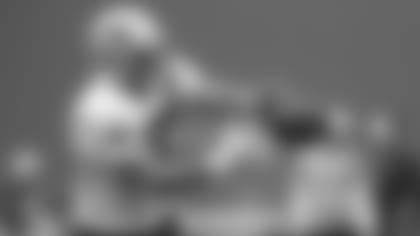**
BB: ** We've had a little bit of a chance here to catch up on the Ravens. It's an impressive football team, like they usually are. Real solid organization, they do a great job from all the way at the top with Steve [Bisciotti] and Ozzie [Newsome] put together a good football team. Well coached, John [Harbaugh] and his staff have done a great job. Play well very in all three phases of the game – excellent on special teams. Obviously the kicker is having a big year; good returner, good specialists, good coverage people. [They've] made a lot of good plays on defense; one of the best situational teams in the league – red area, third down. Big, physical team that's tough to move the ball against. Offensively, they're an explosive group: outstanding quarterback, running backs, tight ends have been solid – [Dennis] Pitta's back – big receivers, physical receivers, good offensive line. They look like the championship team that they are. It will be a big challenge for us down there in Baltimore. [They're] playing well, they've made a lot of key plays at the end of the games when they needed to made them, on offense, defense, special teams, whether it be kicks returned, stops, scores, moving the ball into field goal range, whatever it happens to be. They've made a lot of consistent big plays and they're playing real well right now. It's a good football team. It will be a good test for us down there.
Q: They've had a lot of roster turnover. Who among the guys who have stepped up has stood out to you?
BB: Quite a few of them. Obviously, [Marlon] Brown offensively; those new guys on the offensive line. They added some guys in the secondary. They added some guys in the kicking game, or younger guys that maybe didn't play much last year but have taken on a bigger role this year. They have them across the board: young players stepping up and new players on the roster.
Q: How has the return of Dennis Pitta changed the way they do things offensively since the start of the year?
BB: I don't think it's changed a lot. But they've actually gone to more three wide receiver sets recently, which earlier in the season they were doing some of that but not as much. Now they seem to be more, kind of like what Denver did, just being in that three receiver set on every down, no huddle – not like, no fast pace no-huddle, race track no-huddle, but no-huddle with three receivers in there. They kind of morphed into that somewhere around five, six weeks ago. They did it against us last year in the playoff game, so it's not anything new but it's just kind of one of their – they have a couple modes of playing and that's been the one they've use the most of lately. We have to be ready for everything, but that's what they've done lately. Btu obviously he's a go-to guy and he's made some key plays for them in the last couple games that he's been involved in. there's no question about his importance to the offense. But I don't think the playing style has been dramatically different. He's only played about half the game in the last couple weeks. He's obviously working his way back in but he's a force out there.
Q: Was Nate Solder diagnosed with a concussion on Sunday?
BB: We'll give our injury report after practice today and update you on that.
Q: If a player does suffer concussions in back-to-back weeks, does it change the protocol at all?
BB: Whatever the medical department does, that's what they do. I'm not a doctor. I don't really know what the medical procedures are, period. Like I said, we have a deal: they don't call plays, I don't play doctor.
Q: Does it raise concern when a player has that type of injury?
BB: Our medical department handles all the injuries.
Q: How has Dean Pees changed? Obviously there's no Ray Lewis or Ed Reed and with all the turnover on defense, has he changed what he does with the new faces?
BB: Yeah, I think you change a little bit every year based on the teams that you play and the personnel you have defensively. But I don't think there's a dramatic change, no. I don't see that. What they do in one game against one team might be different than what they do against another team but fundamentally I haven't – I've watched every game now – I don't think there's been anything we've sat there and looked at and said, 'Oh my God, we've never seen him do that before, they've changed their whole defense.' They do what they do. They game plan for each team and they do different things but they're things they've done before in the past. They change it up, they give you a bunch of different looks, now. They don't do the same thing every time, I'm not saying that. But within their broad spectrum of defense, they narrow it down and play each individual game based on that opponent and then the next week it might be some different things but still things within the overall framework of their system.
Q: What does Elvis Dumervil bring that they didn't feature before?
BB: Well, [Paul] Kruger had a pretty good year for them last year and they had Jarret Johnson before that. But he's another good edge rusher. He's certainly a good football player, brings a lot to them, but they've had good production from that position in years past. He's fast, he's a very powerful rusher; in spite of his height, he rushes with a lot of power. He has good arm length, good quickness, he's a disruptive guy. They use him a lot in passing situations, at least they did last week. Not that he isn't capable of playing on all downs, but it seems like he's in there a little bit more on passing situations.
Q: Is what Dean Pees is doing there similar to what he was doing with you guys or is it a continuation of what he'd done over the years?
BB: I'd say that what we were playing when he was here, what they're playing in Baltimore I'd say is a little bit different. There are some fundamentals that are the same but I'd say structurally it's a little bit different.
Q: So is it more of a continuation of what he'd done over the years?
BB: Yup. I'd say if you look at the Baltimore defense over the last decade that you'd see a lot of consistency in that defense regardless of who the coordinator was. They've had three since Rex [Ryan] was there and all the way through with Chuck [Pagano] and Dean. They've had multiple coordinators but I'd say their defensive system has been pretty consistent. Some variations from year to year obviously and they've evolved but I would say the foundation of it looks pretty consistent.
Q: With everything going on with football, can you talk about your strategy and how you effectively execute your holiday shopping?
BB: Poorly.
Q: Do you have a favorite Christmas song?
BB: Actually, I enjoy all of them. I really do. Pretty much whichever one comes on, it puts a smile on my face. It's a great time of year.
Q: You've said teams you play a lot are like division games. Is this an example of that?
BB: Sure. We played them twice last year. Yeah, they're a team that we're familiar with but again, there are a lot of changes from the last time we played them, just like there are when you play division games. But we're certainly familiar. They have a lot of carryover in their staff, a lot of carryover of their personnel, a lot of carryover of their scheme. But it's different and we're different so it's the same but it's different.
Q: Is it more difficult for receivers who primarily play on the outside to move inside or vice versa?
BB: That's a good question. It's an interesting question and it's certainly one that that whole conversation is one that we spend a lot of time talking about as a scouting staff, in terms of evaluating players and scouting players. Let me say this, first of all, I think it depends on obviously what the players are asked to do. Not every outside receiver plays like every other outside receiver, just like every inside receiver doesn't play like every other inside receivers. There are some things that some inside receivers do that are similar but also there are some that are very different from what other guys do. So I'd say, again, it depends what you're looking for. If you're looking for an inside receiver to do things that are similar to what outside receivers do, then I'd say that transition is probably not that big of a deal. If those routes and the type of passing game that's done on the inside part of the field is quite a bit different from the outside part of the field, then you're probably looking at mostly different type of guys. Obviously some players are good enough to play anywhere. Then there are other guys that probably fall into more of one role or the other. But forgetting about all that for the moment, I would say that the game inside in the slot is different from the perimeter because of the number of people that are involved. You're not just looking at – a lot of times outside, you're pretty much dealing with one guy. It's the wide receivers and the corner. You have to have an awareness of the safety, whether he's over the top or rotated in the middle or into a seam area. That's pretty much about it, for the most part. When you're inside, you have a corner outside, you have a slot defender, you have a safety, you have a linebacker so there are at least four guys that you really, I would say, pretty much have to deal with one of them or two of them one way or another. That creates a lot more variables than playing on the perimeter. I'm not saying it's harder [or] easier, it's just different. The same thing is true on defense covering that position. You have the proximity of the next inside player, the next outside player and some type of player in the deep part of the field, unless it's an all-out blitz. That changes the relationship a lot from what it is when you're playing on the perimeter as a corner. You just don't have that – you have the sideline but you don't have the number of players. So in terms of like, what does this player do? What does that player do? I think it starts with, like anything else, just like if you were hiring someone for a job – what's the job description? What do you want that player to do? Once you prioritize what you want that player to do, then you try to fit the player into that job description. Some of the things they have to do are the whole intelligence of recognizing different coverages and different relationships. How much do you want a vertical speed guy that can go in there and get through the middle of the defense? How important is blocking in the running game because it's going to be a factor when you're in there that close. How important is quickness and creating separation on five to seven-yard type routes on third down. What's your priority? Then you want to get a player that fits those priorities.
Q: Do you feel like Julian Edelman and Danny Amendola have been able to find success both inside and outside this year?
BB: Sure, yeah. But I think a lot of times you see, sometimes even our outside receivers in more of an inside position, where they'll stack or come together. So which guy is the inside guy, which guy isn't? There's some of that too. Yeah, I think they have both been successful there. They both have the versatility there. I would say our team uses multiple inside receivers, whether it's the inside receiver or whether it's an outside guy that also can work somewhere into the middle of the field. I would say not all teams do that.
Q: How many players have you had that could do what Logan Mankins did when he moved from guard to tackle on Sunday? I know you've said before you thought he could play all five positions on the line.
BB: I think Logan could, yeah. I think there are guys that can do it and then there's the level that it can be done at. That's another question. Logan has a lot of versatility and certainly when we watched him at Fresno [State] it was all left tackle. I think there's no question that he could have played left tackle in this league, played for us. But we had [Matt] Light there, we put him into the lineup right away at left guard and he and Light played together for [six] years and then we got [Nate] Solder and that was kind of the way it worked out. I don't think there was ever a thought from the coaching staff or from myself that he couldn't play left tackle. That's wasn't it. It was more, 'We have a left tackle and he could play guard.' Then the whole Light-Solder transition, we actually had two left tackles in '11. As opposed to Light who we drafted as a left tackle, looked at him at right tackle and guard – two brilliant moves on my part – and then figured out that he was one of the better left tackles in the league for the next decade. I think it could have easily worked out that way with Logan had the circumstances been different. But that's what it was.
Q: Do you have any comparable players from your years?
BB: Well, you take a guy like Solder as an example, who came in as a rookie and played tight end and right tackle. You look at Jonathan Ogden who was drafted by the Ravens and played left guard his first year when Tony Jones was the tackle and the next year they moved him back out to tackle. A guy like Vince Wilfork, who was drafted obviously as a defensive tackle, in his rookie year he primarily played defensive end, we had Ted Washington. I think players like that that are elite players, you're going to find a way to get them in the lineup somewhere and sometimes the circumstances are not at what ends up being their primary position. But guys that can play a lot of different spots, there's certainly a lot of value to that. I'm sure there's a lot of players like that in the league but if you take a player, like Solder, if you take player and you don't really have a left tackle then he's a left tackle for his whole career and that's the end of the conversation. But sometimes when you have a player and you have another player at that position then in the interim, you work him into the lineup somewhere and you see that versatility. When we have Steve Everitt at Cleveland, he was drafted at center but he played guard and he could have played tackle. [Damien] Woody was another one. Woody played center here, then he played guard when we went into the shotgun, then he played guard, then played right tackle with the Jets. I'd say in the end tackle was probably the better position for him than center because it's taking the ball out of his hands.
Q: How was Ogden as a guard?
BB: Big. It was pretty hard to get through that side of the line. He was very good. He's probably even better as a left tackle just because of the need at that position. When they took him and they had Tony Jones, which was the year after I was there, but Tony Jones was a real good left tackle and Orlando Brown was the right tackle, so it didn't really look like they needed a tackle. But I think the decision to not pass up a Hall of Fame player like Ogden and draft him as a left tackle and ultimately be the franchise left tackle for the next decade was a good value pick. But for that one year, '96, he played left guard. Yeah, he was pretty good.
Q: With LeGarrette Blount's size and running style, does he remind you of anyone that you've had?
BB: When you watch him run, you don't think he's 250 pounds. But he's 250 pounds or 245, whatever he is. But he has, I would say, rare quickness and athleticism for that size as well as power. We've seen him run through plenty of tackles but he's also nifty and quick enough in the open field that he certainly doesn't look like a fullback running the ball. There's a difference when [James] Develin carries it and LeGarrette carries it. We all see that style difference. He's got a pretty unique skill set that way. To be that big and have that kind of quickness and movement skills, relative to the Christian Okoyes or Brandon Jacobs, those guys who, they're downhill runners but I'd say LeGarrette has more quickness and more wiggle than some guys like that that come to mind. He's got a good running skill set, very good.
Q: Ottis Anderson maybe?
BB: Ottis was two and a quarter. He looked bigger than that but honestly, for as big as Ottis was, he was 220. This is a bigger man than that. I'd say Ottis was more of a halfback. He could run outside. He was a big back but he was a big halfback. But LeGarrette has some of that same quickness, some of that running style, he's just bigger. Watching Ottis return kickoffs in college, that was a sight. To see him with a full head of speed, 225 pounds at Miami, coming back there behind the wedge, there wasn't a lot of guys that wanted to go down there and get in front of that train, I'll tell you. It's one thing when they hand him the ball six yards behind the line of scrimmage, it's another thing when he catches it in the end zone and hits the 25-yard line.
Q: Was that part of the thinking of putting Blount back there?
BB: And just his overall skills. LeGarrette, he didn't have a lot of great running opportunities but he still made good yardage back there returning those kicks. Guys had a hard time tackling him and a guy like that gets a full head of steam going in there, he made a lot of yards on his own, even though we didn't have a lot of long runs to show for it but I thought he ran well, like he always does.








































